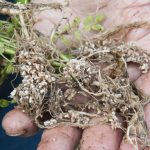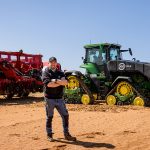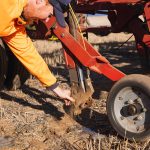Learning the ABCs of liquid delivery
SARAH JOHNSON
SANTFA The Cutting Edge WINTER 2012
Frustrated by the lack of response to granular fertilisers in dry sowing conditions and non-wetting soils, Cleve farmers Matthew and Taris Price have changed to liquid fertilisers to make nutrients immediately available to their crops.
The brothers, with their father John, crop 12,000 ha, most of it south-west of Cleve on Eyre Peninsula. Wheat is their main crop, with feed and malting barley, lupins and canola also part of the rotation.
They have been using liquid fertilisers for three years.
“With the liquid fertilisers crops just jump out of the ground straight away,” said Matthew. “We’ve got some pretty gutless sand, and they never used to do that with granular fertiliser. It takes a lot of moisture to break fertiliser down in non-wetting sand.”
Average annual rainfall varies from 300 to 350 mm across their properties.
Before investing in a liquid system the Price brothers embarked on a research
road trip to WA, attending the Dowerin Field Day and visiting 11 farmers in different regions.
According to Matthew, ‘unless we’re going to do it properly, we’re not going to do it at all’, is an attitude they share.
“We didn’t jump into it. We did a lot of homework, because you can come unstuck pretty quickly,” he said. “We knew we wanted to get into liquid, so we made the special trip to WA to review various liquid systems. It’s how we made a decision on what would best suit our program.”
They chose the G22 and SPIKER systems from Liquid Systems (SA), an Australian- owned company that specialises in the design and manufacture of in-furrow liquid injection equipment and is headed by Peter Burgess.
“We were going to make our own equipment and it would have been far cheaper doing that, but farmers using liquid fertilisers told us not to mess around; spend the money and you’ll benefit in the long run,” said Matthew.
“We haven’t had any hiccups with the Liquid Systems gear and Peter Burgess’s back up and support has been brilliant.”
The G22 is a dual, auto-rate system that enables simultaneous application of two separate liquids at different rates. The SPIKER equipment is designed to inject concentrated chemical directly into the main delivery line. The Prices use it to incorporate neat trace elements into one of the nutrient lines.
The dual liquid system is necessary due to their use of ammonium polyphosphate (APP) solution that is incompatible with the sulphate form of trace elements they have chosen to use instead of the more expensive oxide form.
“This is the only downside of APP,” said Matthew. “From our experience it isn’t compatible with sulphates, which are a lot cheaper, so we needed the second line so we could keep the APP and trace elements separate.”
Their change from granular to liquid fertilisers coincided with a decision to upgrade their seeding equipment, which saw them replace their two Horwood Bagshaw machines with two new 18-metre Seed Hawk tined seeders, which they assembled on farm.
The Seed Hawks have a double tine arrangement, with the primary tines opening up the furrow for delivery of the fertiliser and a secondary seed tine off-set 35 mm to the side of each main ‘fertiliser’ tine.
Each of the seeders carries a custom- designed 12,000-litre Freedom liquid tank and a separate 680-litre water tank for flushing out the liquid lines and hand washing.
The fertiliser tanks are divided into three compartments – 7,000, 4,000 and 1,000 litre capacity. The Prices use the 4,000-litre compartment in each tank for the APP solution, with a mix of UAN, fungicide and water in the 7,000-litre compartment and concentrated trace elements in the 1000-litre section.
The dual lines of the G22 system carry fertiliser from the 4,000 and 7,000 litre compartments to the Seed Hawk’s fertiliser tines.
The APP solution is applied at 30 L/ha – 22 L/ha of APP with 8 L/ha of water – and the mixture from the large compartment at 35 L/ha, which distributes 10 to 20 litres of UAN, depending on the concentration and 200 millilitres of Endura Impact fungicide. Trace elements
are injected into the UAN line at a rate of 3.5 L/ha through the SPIKER system.
In the three years they have used liquid delivery they have experimented with various rates of trace elements, with mixed results.
In the first year they applied 4 L/ha of a trace element mix containing 60 grams of zinc, 85 grams of manganese and 12.5 grams of copper a litre. They also mixed the fungicide with the trace elements, which caused problems.
“Back then, we weren’t working around the clock and we found the fungicide formed a thick slurry on top of the solution due to a lack of agitation during the break,” said Matthew. “We had to stir it all up again. Since then we’ve combined the Endura Impact with the UAN and haven’t had any hiccups.”
In the second year of liquid delivery they decided to increase the trace elements rate, applying 6 L/ha of a mixture containing 83 grams of zinc, 56 grams of manganese and 16.6 grams of copper a litre to maximise the amount available to plants.
“Because sulphates are so cheap compared to oxides we tried to deliver more to the plants but it was an absolute nightmare,” said Matthew. “It was so concentrated that we had issues with the copper dropping out due to the pH of our water.
“When the copper dropped out it blocked the jet on each UAN line and we were forever under the air seeder bar trying to unblock things.
“We ended up using a lot of citric acid – up to 3 kilograms per 1000 litres of water – to try to reduce the pH to near neutral so the copper didn’t drop out.
“Also, because the spiker has great agitation, the return line going back into the tank was dropping liquid from the top of the tank, causing oxidisation. Once this was fixed things improved greatly.
“We ended up putting more water in with the trace element brew to keep it in suspension and eventually we got there through experimentation and support from Brenton Wilhelm.”
The Prices buy their trace elements through Brenton Wilhelm of Wilchem Australia, who formulates the trace element mix in bulk quantities in Adelaide then transports it to the EP property.
After last year’s problems they decided to apply only zinc at seeding this season and will apply copper and manganese as a foliar spray. Matthew concedes this was the advice provided by many people during their initial research.
“Everyone told us we were wasting our time putting copper and manganese down the same tube, but with such a big cropping program we thought it would be the most efficient option,” he said. “We thought if it’s done at seeding, then
it’s one less job later on, but we’ve actually started to eat our words.”
Making fertilisers immediately available to plants on non-wetting soils and in dry sowing conditions provided the main impetus for the Price’s investment in liquid delivery.
Previously they applied 18:20 or 27:12 DAP granules through the seed tube, but found the nutrients from the granules took too long to become available, depending on rainfall.
“With a granular fertiliser, if it’s been a dry year the nutrient isn’t available until moisture breaks the fertiliser down. In many seasons we’d dig in the soil a month after applying 18:20 DAP and still find
granules. They’re just not available until you get enough rain,” said Matthew. “With a liquid stream the nutrient is available immediately.”
Granular fertiliser also caused problems with hose blockages and durability. “The 27:12 DAP product had a lot of nitrogen, which caused the air seeder hoses to block when it was wet. The granules were also abrasive on the hoses, as there was often a lot of dust in the fertiliser. Now our air seeder hoses are lasting longer,” said Matthew.
APP, an option suggested four years ago by Michelle Bammann, is a critical part of their fertiliser program.
“Although not used a lot in Australia, APP is really big in the US and is one of the most available forms of phosphorus (P),” said Michelle, a private agronomy consultant in Clare. “In Bob Holloway’s trial work at SARDI’s Minnipa Research Centre, the worse result APP ever gave was as good as any other fertiliser. In highly calcareous soils like many of those on EP it’s going to be a winner and in non-wetting sands, which the Prices have a fair portion of, it’s a winner because it’s readily available.
“The P in APP is in a plant-available form, so it can be taken up as soon as the roots reach it, whereas a granule has to attract moisture to be able to disperse.
A lot of the time non-wetting sands don’t wet up enough to disperse the P granule in time for it to be available to plants in the early growth stages when P is critical. Phosphoric acid will give a similar result, but in my opinion, it is not as good as APP.”
The Prices originally considered phosphoric acid, as it is able to be applied with sulphate trace elements, but were deterred by the potential occupational health and safety risks.
“Phosphoric acid isn’t user-friendly from a safety point of view. We have four work- men doing 12-hour shifts during seeding. It’s just too dangerous,” said Matthew.
APP contains P in the form of polyphosphate and nitrogen in the form of ammonium.
Polyphosphates are long-chain phosphate polymers that provide a slow release source of P to maintain even growth. The Prices use 16-23-0 APP, which delivers 16 units of nitrogen and 23 units of phosphorous in each 100 litres of solution.
“It’s a brilliant product,” said Matthew. “Our crops boom out of the ground. They’re just a lot healthier. We’ve used it on leased properties that don’t have a good fertiliser history and it’s amazing how well the crop grows.”
However, he cautions, the initial set up requirements and transport issues are daunting.
APP is manufactured in Texas and shipped to Adelaide in 18,000-litre bladders inside shipping containers. Delivery takes six weeks from the time of order.
The containers are trucked to the Price property, where Matthew and Taris pump the APP out of the bladder into storage tanks. They have 14 liquid fertiliser storage tanks on their farms, ranging in size from 36,000 to 42,000 litres.
Storing APP does not appear to have an adverse effect on the product, based on their experiences this season, when they used some bought for last year’s program.
“It does settle a bit, so you do get a bit of residue at the bottom of the tank. I pumped it all out into 1000-litre shuttles to get a better look at it,” said Matthew. “It was a bit of messing about but I didn’t want to be caught out and we didn’t have any problems with it.”
A set of cartage tanks mounted on a 13-metre trailer are used to fill the fertiliser tanks on the seeders at the end of each 12-hour shift. Matthew refills the fertiliser tanks while Taris takes care of the seed, which goes into a 10-tonne tow-behind seed cart. The process takes up to 30 minutes.
The seed and fertiliser capacity of each rig allows the operator to sow 130 ha between fills; more than twice the 60 ha they could cover between fills when using granular fertilisers.
“The hoppers in the seed cart are relatively small for the size of our cropping program but now we are using fluid fertilisers we can fill the whole box with seed,” said Matthew. “There is enough capacity for us to sow 130 ha at a rate of 65 kg/ha. Our liquid tanks also carry enough for the same area so it marries up well. We were filling our air seeder boxes with granular fertiliser every 60 ha, so we’ve halved the number of fills.”
The Prices store their untreated seed in temperature-controlled, air-cooled silos to keep the grain cool and free of weevils, with in-furrow fungicide applied with the liquid fertiliser at seeding; an arrangement that means any leftover seed can be sold.
Fungicide is applied on every hectare of their cropping land to minimise the risk of root and leaf diseases including net blotch and powdery mildew in barley, black leg in canola and stripe rust and take-all in wheat.
“On our non-wetting sand we’ve got a lot of Maritime barley, which suffers from net blotch,” said Matthew.
Making fertilisers immediately available to plants on non- wetting soils and in dry sowing conditions provided the main impetus for the Price’s investment in liquid delivery.
“We think putting Endura Impact out as a liquid has made a huge difference. Other farmers might spray propiconazole two or three times during the season to manage net blotch while we might only spray once. We believe it’s because we’ve got a healthier plant.”
The Price family began no-till farming about 10 years ago, starting with two 18-metre Horwood Bagshaw tine machines with knife points and press wheels on 178 mm spacing, which they converted to 268 mm spacing. However, these spring-tine machines were not well suited to the rocky terrain in some of their paddocks, which caused damage requiring extra maintenance and delayed seeding.
Three years ago they sold their livestock to concentrate on cropping, upgraded to their Seed Hawk seeders, which have
hydraulic tines and are set up for 300 mm row spacing, and changed from granular to liquid fertilisers.
They have considered disc seeders but find tined implements best-suited to their non-wetting sands.
“Tine machines drag through the non-wetting sand and mix the wet soil with the dry,” said Matthew, adding that the Seed Hawk tines provide accurate seed placement, leading to more reliable germination.
“The Seed Hawk has amazing seed place- ment. It just gets things up and growing.
“Four years ago we had a small trial with a Seed Hawk next to our Horwood Bagshaw seeders. Germination was probably 10% on land sown with the Horwood Bagshaw machine and 70% with the Seed Hawk in a dry year. It was just amazing.”
Prior to seeding this year they spread 100 kg/ha of sulphate of ammonia on all their cropping paddocks, except those to be sown to lupins, to provide nitrogen for early growth and plan to apply urea and UAN in-crop if crop and seasonal conditions suggest more nitrogen is needed.
Thanks to in-depth homework and support from outside sources the Prices are pleased with the results being achieved with their liquid delivery system, which has proved itself in the past three years and which Matthew and Taris expect to give their crops an advantage when conditions are not as good as they have been in that time.
“We’re finding the plants are healthier and booming out of the ground because, with liquid delivery, all the fertiliser, fungicide and trace elements we are applying are available to the crop.
“We hope this system is going to shine in low-rainfall conditions due to the immediate availability of fertiliser to the plant.”
SANTFA The Cutting Edge WINTER 2012
Get a Quote
"*" indicates required fields






